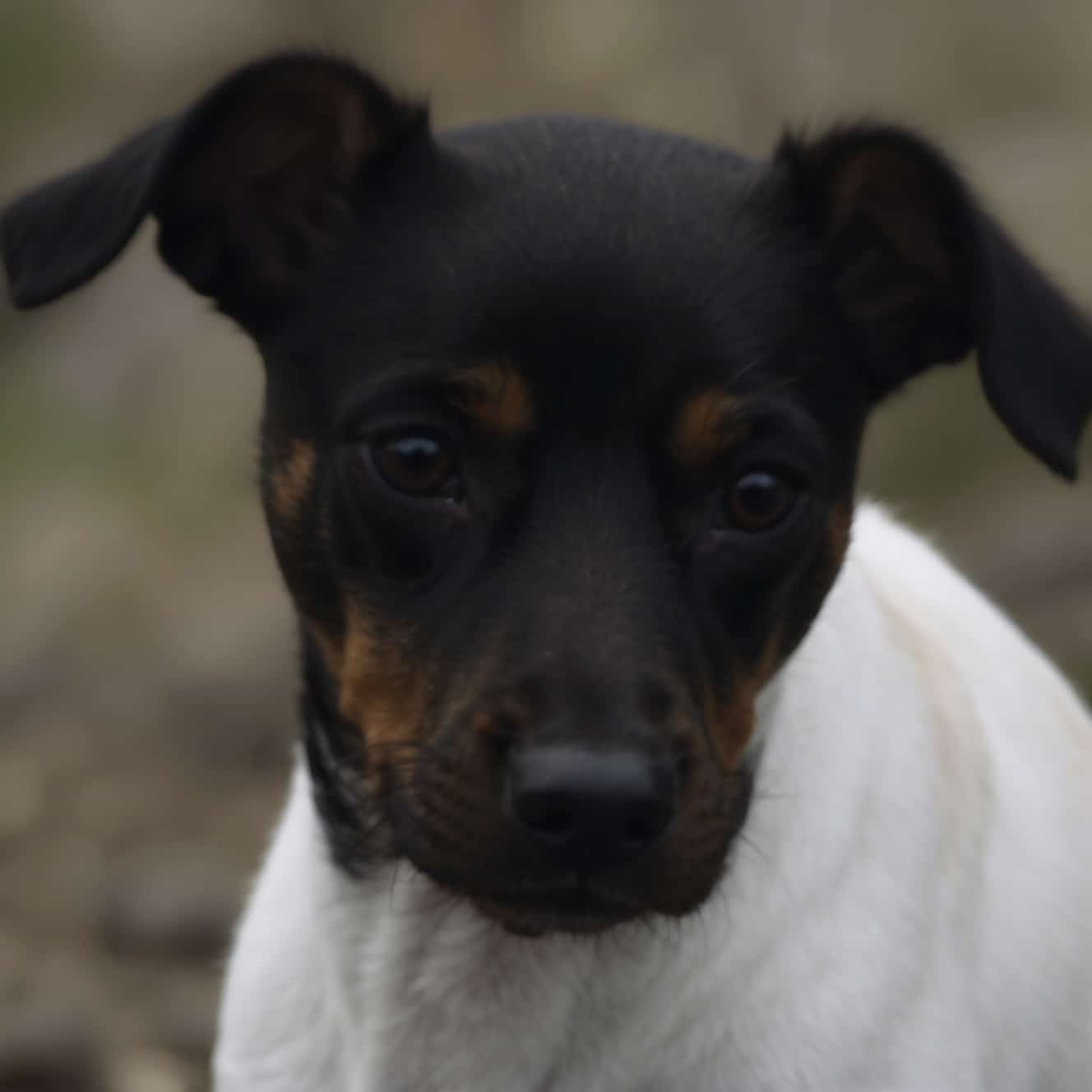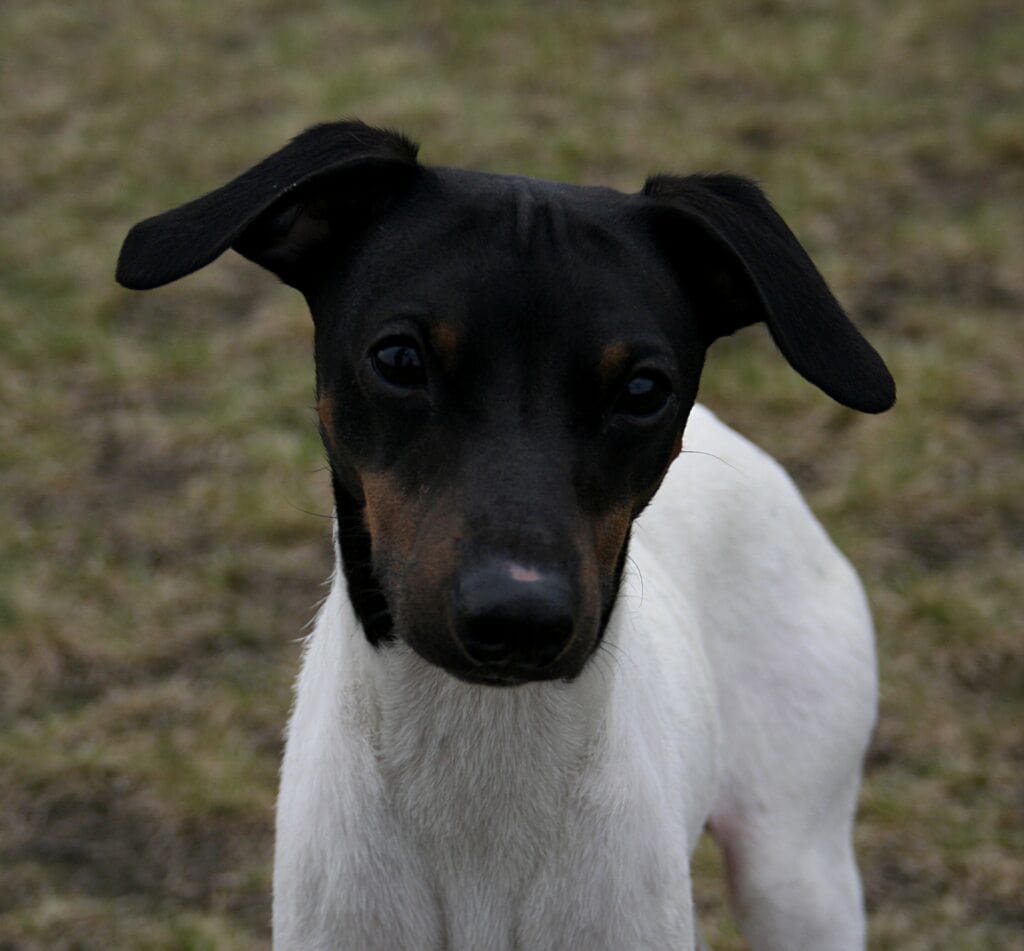The Japanese Terrier, a rare and charming breed, boasts a smooth coat and distinctive markings. Known for its friendly and gentle nature, this terrier makes an excellent companion for families and individuals alike. With a history rooted in Japan, the Japanese Terrier brings a touch of elegance and warmth to households seeking a loyal and affectionate four-legged friend.

| Category (Explanation) | Breed Information |
|---|---|
| Year of Breed Conception | Early 20th century |
| Country of Origin | Japan |
| Weight (lbs & kg) (Male) | 5-9 lbs (2-4 kg) |
| Weight (lbs & kg) (Female) | 5-9 lbs (2-4 kg) |
| Coat Type | Short, smooth coat |
| Color Variations | White with black or tan markings |
| Shedding Level (Low, Moderate, High) | Low |
| Height (cm & in) | 8-13 inches (20-33 cm) |
| Breed Size | Small |
| Trainability (Low, Moderate, High) | Moderate |
| Mental Needs (Low, Moderate, High) | Moderate |
| Intelligence Level (Low, Moderate, High) | Moderate |
| Energy Level (Low, Moderate, High) | Moderate |
| Agility (Low, Moderate, High) | Moderate |
| Loyalty (Low, Moderate, High) | High |
| Playfulness (Low, Moderate, High) | High |
| Exercise Needs | Regular exercise and playtime |
| Guarding Proficiency (Low, Moderate, High) | Low |
| Sociability with Children (Low, Moderate, High) | High |
| Barking Level (Low, Moderate, High) | Moderate |
| Digging Tendency (Low, Moderate, High) | Moderate |
| Destructive Behavior (Low, Moderate, High) | Low |
| Drooling Level (Low, Moderate, High) | Low |
| Obedience Level (Low, Moderate, High) | Moderate |
| Apartment Friendly (Yes/No) | Yes |
| Inherent Prey Drive | Low |
| Physical Risk to Others (Low, Moderate, High) | Low |
| Travel Fatality Risk (Low, Moderate, High) | Low |
| Allergen Potential | Low |
| Health Concerns (List of Common Health Concerns) | Generally healthy with no specific common health issues |
| Average Life Expectancy (Life Expectancy in Years) | 12-15 years |
Woof Mastery is reader supported and our articles may contain affiliate links.
Instead of running third party ads that we have no control of we only use links from high-quality companies we are directly partnered with. Making use of these links come at no cost to you our reader, and in many cases have the extra benefit of discounted rates or sign up bonuses.
If you’re interested you can read more about our affiliate policy here.
We appreciate your support and always insure that the products and services we recommend are high-quality, helpful and relevant to the subject at hand!
The Japanese Terrier, a rare breed with roots in Japan, has a history dating back to the early 20th century. Bred from native Japanese dogs and terriers brought by European traders, this terrier was initially used for hunting and as a companion. Despite its small size, the Japanese Terrier possesses a spirited and friendly nature. Over time, efforts to preserve and promote the breed have contributed to its recognition both in Japan and internationally, allowing more people to appreciate the unique qualities of this charming and rare terrier.

The Japanese Terrier is special for its rare and charming presence. Known for its friendly and gentle nature, this terrier stands out as a delightful companion. Its history and rarity add to its special status, making it a unique and cherished breed. The Japanese Terrier’s ability to bring warmth and affection to its family, combined with its distinct appearance, sets it apart as a special and endearing canine friend.
The Japanese Terrier’s traditional role dates back to the early 20th century in Japan. Bred from native Japanese dogs and terriers brought by European traders, this terrier was initially used for hunting and as a companion. Despite its small size, the Japanese Terrier possesses a spirited and friendly nature. Its traditional role as a companion and rare breed has continued over the years, with efforts to preserve and promote the breed contributing to its recognition both in Japan and internationally, allowing more people to appreciate its unique qualities as a charming and rare terrier.
Japanese Terriers are recognized for their rare and charming personalities. They are known to be friendly, gentle, and affectionate. Despite their small size, they exhibit a calm and adaptable nature. Japanese Terriers form strong bonds with their families and are often described as delightful companions. Their rarity adds to their special status, making them unique and cherished members of households. With their friendly demeanor and endearing qualities, they bring warmth and affection to those fortunate enough to have them as part of their lives.
Japanese Terriers are known for their friendly and gentle temperament. They typically form strong bonds with their families and are affectionate companions. Despite their small size, they can display a calm and adaptable nature. Early training and socialization contribute to their well-rounded temperament. Japanese Terriers may be reserved with strangers, but they usually warm up with proper introductions. Their rarity adds to their special status, making them unique and cherished companions. With consistent positive reinforcement and a loving environment, Japanese Terriers develop into delightful and well-mannered family members.
Japanese Terriers are small, compact dogs with a fine and well-balanced build. They have a slightly rounded head, a short muzzle, and a well-defined stop. Their eyes are dark and expressive, and their ears are small and fold forward. The breed has a short, smooth coat that comes in white with black or tan markings. Japanese Terriers have a level back, a high-set tail, and a brisk, agile gait. Despite their small size, they convey a sense of elegance and charm.
Japanese Terriers typically come in a tricolor pattern, adding to their charming and distinctive appearance. The most common color variations for Japanese Terriers include:
Japanese Terriers typically have a white coat with black or tan markings. The breed’s coat pattern is relatively consistent, with well-defined markings on the head, ears, back, and tail. The black or tan markings are symmetrical and contribute to the breed’s distinctive appearance. While variations in coat pattern may occur, the black and tan pattern is a standard and recognizable feature of the Japanese Terrier.
Japanese Terriers have a low shedding level. Their short, smooth coat sheds minimally, and regular grooming helps keep the coat healthy. Brushing the coat once or twice a week removes loose fur and promotes a shiny coat. While Japanese Terriers are not heavy shedders, consistent grooming practices contribute to their overall well-being.
Japanese Terriers have a short, smooth coat that is relatively easy to maintain. Grooming practices for Japanese Terriers include:
Brushing: Regular brushing with a soft bristle brush helps remove loose hair and keeps their coat shiny. This can be done about once or twice a week.
Bathing: Japanese Terriers typically do not require frequent baths. Bathing them as needed, using a mild dog shampoo, is sufficient to keep them clean.
Ears: Check and clean their ears regularly to prevent wax buildup or infections. Use a damp cotton ball or a veterinarian-recommended ear cleaning solution.
Nails: Keep their nails trimmed to a comfortable length to avoid discomfort and maintain proper foot health.
Teeth: Dental hygiene is important. Brush their teeth regularly with a dog-friendly toothbrush and toothpaste. Dental chews or toys can also contribute to oral health.
Eye Care: Keep an eye on their eyes for signs of irritation or discharge. If necessary, use a damp cloth to clean around the eye area.
Japanese Terriers have a moderate activity level. These small terriers enjoy playtime and regular walks to meet their exercise needs. While they are not excessively hyperactive, providing mental stimulation through training sessions and interactive toys is important. Japanese Terriers thrive on companionship and may enjoy engaging in activities with their owners.
Japanese Terriers exhibit intelligence in their attentive and affectionate behavior. While they may not be ranked as the most obedient, their social intelligence shines through in their relationships with family members. Consistent training, positive reinforcement, and socialization contribute to bringing out the best in their intelligent nature.
Japanese Terriers have a need for mental stimulation. Engage them in activities that challenge their minds, such as puzzle toys, obedience training, or interactive games. Social interaction is crucial for their well-being, so provide regular companionship and attention. Training and obedience sessions contribute to mental stimulation, reinforcing the bond between the owner and the dog.
Enter The Woof Mastery

Before bringing a Japanese Terrier into your home, consider the following:
Japanese Terriers, being small in size, generally pose a lower physical risk to others. However, like any dog, they may exhibit behavioral issues if not properly socialized and trained. Early socialization and positive reinforcement training are essential to ensure they interact well with people and other animals.
Japanese Terriers, being small in size, are generally well-suited for families with children. Supervision is important, especially with very young children, to ensure gentle interactions. Early socialization is crucial to shape their behavior around kids. They can be affectionate and form strong bonds with children, making them suitable companions for families.
Japanese Terriers may have varying responses to water. Some individuals may enjoy swimming, while others may not. If you plan to introduce them to water, do so gradually and observe their comfort level. Use a canine life vest if swimming in unfamiliar or potentially challenging conditions.
Remember that Japanese Terrier puppies, like all puppies, are eager to please and learn. Positive and consistent training practices will help them become well-behaved, obedient, and happy adult dogs. Building a strong and trusting bond with your puppy through training is a rewarding experience for both you and your canine companion.
Japanese Terriers are not known for being particularly noisy. They may bark occasionally, especially if they sense something unusual. Early training and positive reinforcement can help in maintaining good behavior and preventing excessive barking.
Japanese Terriers do well in homes with owners who can provide regular exercise and mental stimulation. They adapt to various living conditions, including apartments, but they enjoy outdoor play. Socialization is important to prevent shyness or aggression. Positive reinforcement training is effective in shaping their behavior.
Traveling with Japanese Terriers involves considerations for their size and comfort. Choose a suitable carrier or crate that provides ventilation and security. Pay attention to temperature conditions and avoid leaving them in hot environments. Provide regular breaks for stretching, hydrating, and bathroom breaks. Secure them appropriately in a vehicle to prevent injuries. If flying, adhere to airline policies regarding crate size and safety standards for small breeds.
Japanese Terriers may be susceptible to specific health concerns. While not all individuals will experience these issues, it’s crucial for Japanese Terrier owners to be aware of potential health problems and collaborate with veterinarians to maintain their pets’ well-being. Common health concerns in Japanese Terriers include:
Regular veterinary check-ups, a balanced diet, dental care, and responsible breeding practices can contribute to the overall well-being of Japanese Terriers. Owners should be proactive in monitoring their pets’ health and seeking veterinary attention if any concerns arise.
Proper nutrition is crucial for the health and well-being of Japanese Terriers. Here are some nutritional habits and best practices to consider for this breed:
Breed-Specific Laws (BSL): Japanese Terriers may be subject to breed-specific laws (BSL) in certain areas. These laws are often enacted at the local or municipal level and can vary widely from one jurisdiction to another.
Types of Restrictions: The specific restrictions imposed on Japanese Terriers under BSL can include mandatory spaying/neutering, special licensing, liability insurance requirements, muzzling in public, and, in some cases, bans on ownership. The severity of these restrictions depends on local regulations.
Rationale for BSL: BSL is typically implemented based on concerns about public safety and perceived risks associated with specific breeds, often due to incidents involving dog attacks. While Japanese Terriers are not inherently aggressive, they can be affected by BSL due to their physical resemblance to breeds that are sometimes included in these laws.
Controversy: It’s important to note that BSL is a controversial topic. Critics argue that it unfairly targets breeds rather than addressing individual dog behavior and that responsible ownership and training should be emphasized instead of breed-specific restrictions.
Local Regulations: To determine if there are breed-specific laws or restrictions regarding Japanese Terriers in your area, you should check with your local animal control or government authorities. Be aware of and comply with any local regulations to ensure that you are in compliance with the law while owning a Japanese Terrier.
Woof Mastery is reader supported and our articles may contain affiliate links.
Instead of running third party ads that we have no control of we only use links from high-quality companies we are directly partnered with. Making use of these links come at no cost to you our reader, and in many cases have the extra benefit of discounted rates or sign up bonuses.
If you’re interested you can read more about our affiliate policy here.
We appreciate your support and always insure that the products and services we recommend are high-quality, helpful and relevant to the subject at hand!
Myth 1: Japanese Terriers are Aggressive
Myth 2: They are High-Maintenance
Myth 3: Japanese Terriers are Not Good with Children
Myth 4: They Cannot Adapt to Apartment Living
Myth 5: Japanese Terriers are Rare and Exotic
Myth 6: They are Not Intelligent
Myth 7: Japanese Terriers Require Excessive Exercise
Myth 8: They are Allergic to Everything
Myth 9: Japanese Terriers Don’t Shed
Myth 10: They Cannot Be Trained for Tricks
Understanding the true nature and characteristics of Japanese Terriers is essential for potential owners to provide them with the care and environment they need to thrive.
Famous Japanese Terrier examples are not as widely documented, but these small and agile dogs can be found as delightful companions in homes where their unique appearance is cherished.
The Japanese Terrier is culturally significant as a small and agile breed with a distinct appearance. Originally developed in Japan, these terriers are known for their friendly and lively nature. While their historical roots are not widely documented, Japanese Terriers have become valued as companions. Their unique appearance and charming personality contribute to their recognition in popular culture. Japanese Terriers are symbols of agility and companionship, finding appreciation among dog enthusiasts who appreciate their endearing qualities.
The Japanese Terrier is culturally significant as a small and agile breed with a distinct appearance. Originally developed in Japan, these terriers are known for their friendly and lively nature. While their historical roots are not widely documented, Japanese Terriers have become valued as companions. Their unique appearance and charming personality contribute to their recognition in popular culture. Japanese Terriers are symbols of agility and companionship, finding appreciation among dog enthusiasts who appreciate their endearing qualities.
Japanese Terriers, being a rare breed, have faced specific challenges over the years. Some notable challenges include:
The Japanese Terrier is a small terrier breed developed in Japan. Contributing breeds may include:
Japanese Terriers, with their charming and spirited demeanor, add a touch of joy to every household. Their small size and friendly nature make them ideal companions for families and individuals alike. Their adaptability to various living conditions allows them to fit seamlessly into urban and suburban settings. Engaging in interactive play and providing them with the attention they love strengthens the special bond they share with their families, making them cherished members of the home.